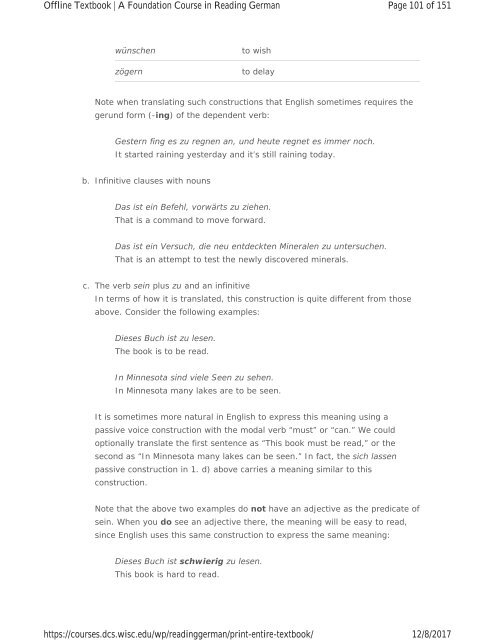A Foundation Course in Reading German, 2017a
A Foundation Course in Reading German, 2017a
A Foundation Course in Reading German, 2017a
You also want an ePaper? Increase the reach of your titles
YUMPU automatically turns print PDFs into web optimized ePapers that Google loves.
Offl<strong>in</strong>e Textbook | A <strong>Foundation</strong> <strong>Course</strong> <strong>in</strong> Read<strong>in</strong>g <strong>German</strong><br />
https://courses.dcs.wisc.edu/wp/read<strong>in</strong>ggerman/pr<strong>in</strong>t-entire-textbook/<br />
Page 101 of 151<br />
12/8/2017<br />
wünschen<br />
zögern<br />
to wish<br />
to delay<br />
Note when translat<strong>in</strong>g such constructions that English sometimes requires the<br />
gerund form (-<strong>in</strong>g) of the dependent verb:<br />
Gestern f<strong>in</strong>g es zu regnen an, und heute regnet es immer noch.<br />
It started ra<strong>in</strong><strong>in</strong>g yesterday and it’s still ra<strong>in</strong><strong>in</strong>g today.<br />
b. Inf<strong>in</strong>itive clauses with nouns<br />
Das ist e<strong>in</strong> Befehl, vorwärts zu ziehen.<br />
That is a command to move forward.<br />
Das ist e<strong>in</strong> Versuch, die neu entdeckten M<strong>in</strong>eralen zu untersuchen.<br />
That is an attempt to test the newly discovered m<strong>in</strong>erals.<br />
c. The verb se<strong>in</strong> plus zu and an <strong>in</strong>f<strong>in</strong>itive<br />
In terms of how it is translated, this construction is quite different from those<br />
above. Consider the follow<strong>in</strong>g examples:<br />
Dieses Buch ist zu lesen.<br />
The book is to be read.<br />
In M<strong>in</strong>nesota s<strong>in</strong>d viele Seen zu sehen.<br />
In M<strong>in</strong>nesota many lakes are to be seen.<br />
It is sometimes more natural <strong>in</strong> English to express this mean<strong>in</strong>g us<strong>in</strong>g a<br />
passive voice construction with the modal verb “must” or “can.” We could<br />
optionally translate the first sentence as “This book must be read,” or the<br />
second as “In M<strong>in</strong>nesota many lakes can be seen.” In fact, the sich lassen<br />
passive construction <strong>in</strong> 1. d) above carries a mean<strong>in</strong>g similar to this<br />
construction.<br />
Note that the above two examples do not have an adjective as the predicate of<br />
se<strong>in</strong>. When you do see an adjective there, the mean<strong>in</strong>g will be easy to read,<br />
s<strong>in</strong>ce English uses this same construction to express the same mean<strong>in</strong>g:<br />
Dieses Buch ist schwierig zu lesen.<br />
This book is hard to read.


















